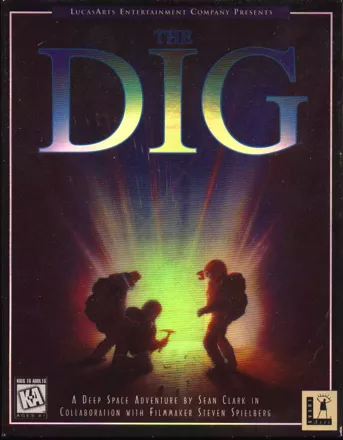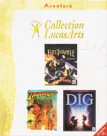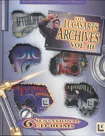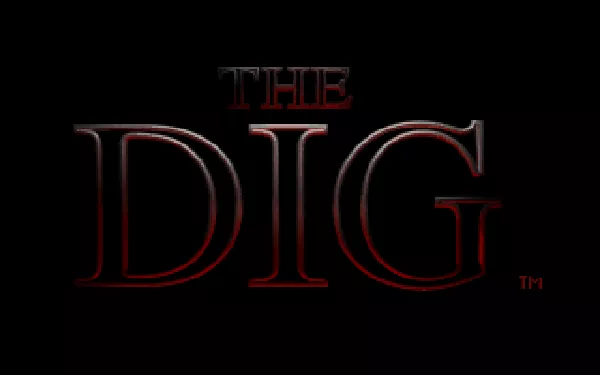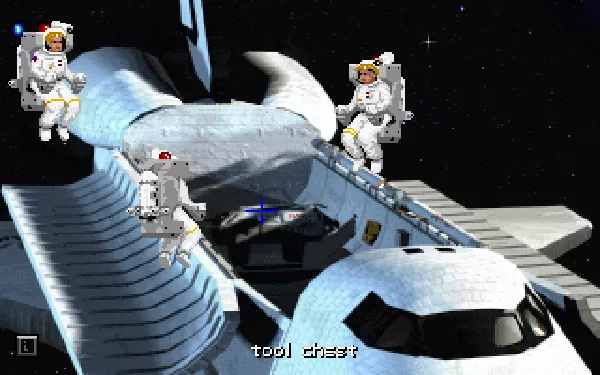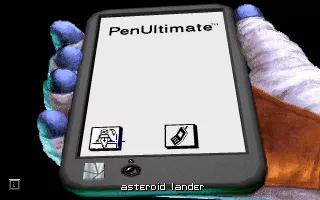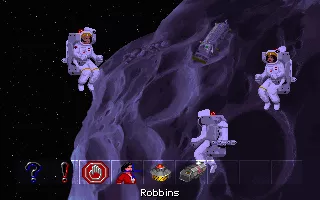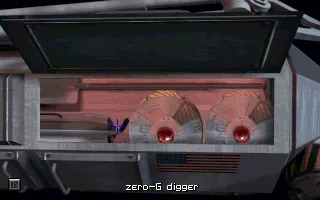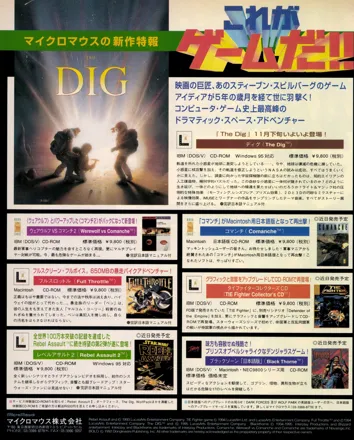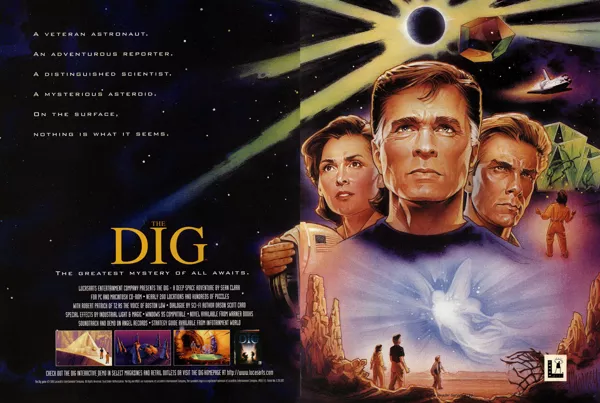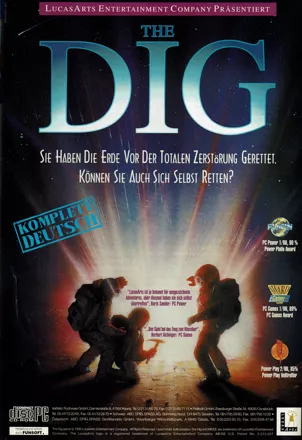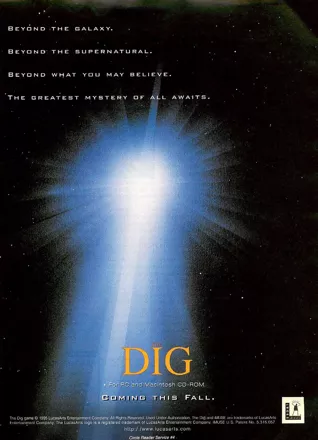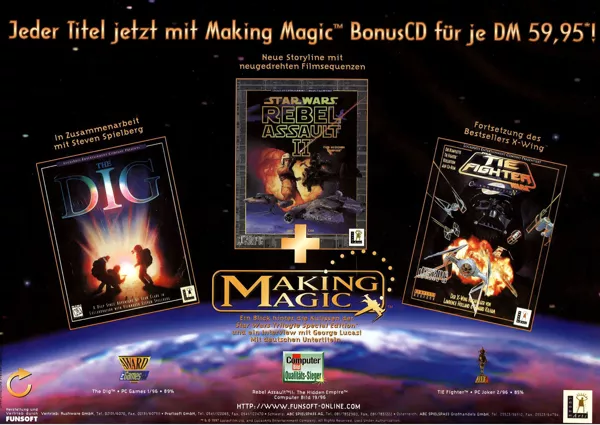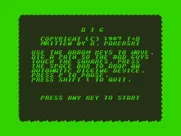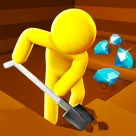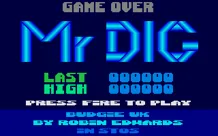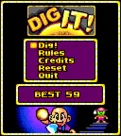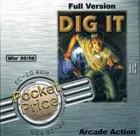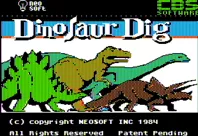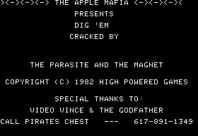The Dig
Description official descriptions
A group of scientists discovers an asteroid that is on its way to a collision with the Earth. Is there any way to prevent the disaster? Boston Low, a NASA veteran, is sent to command a space expedition on the asteroid. Accompanied by the journalist Maggie Robbins and the archaeologist Brink, Boston investigates the asteroid and finds a strange structure that undoubtedly belongs to an alien civilization. During the course of investigations, the team finds itself on a seemingly deserted planet. They have no knowledge of the planet and no possibility of going back. Will they ever discover the secret of this strange world and find a way to get home?
The Dig is a point-and-click adventure game with a simple one-cursor interface. Most of the puzzles are inventory-based, tending to be somewhat more complex than in most preceding LucasArts' adventure games. There are also a few logic-based puzzles, which require understanding and manipulation of alien technology and life forms on the planet. Traditional branching dialogue system is utilized; however, the game focuses more on puzzle-solving than on conversations to advance the plot.
The game's story is influenced by science fiction literature and movies, and strives to be realistic, departing from the comedy style of LucasArts' adventures. Despite that, humorous elements are present in some of the dialogues and text descriptions. The game utilizes hand-drawn graphics with a few pre-rendered 3D images.
Spellings
- 异星搜奇 - Simplified Chinese spelling
- 디그 - Korean spelling
Groups +
Screenshots
Promos
Credits (DOS version)
235 People (207 developers, 28 thanks) · View all
| Designed by | |
| Directed by | |
| Based on a Concept by | |
| Dialogue by | |
| Additional Story by | |
| Additional Additional Story by | |
| Art Style | |
| Creature Concept | |
| Lead Artist | |
| Background Art | |
| Supervising Animators | |
| Animators | |
| Special Effects Animators | |
| Additional Animation | |
| [ full credits ] | |
Reviews
Critics
Average score: 82% (based on 39 ratings)
Players
Average score: 3.9 out of 5 (based on 237 ratings with 21 reviews)
The Good
The Dig features impressive graphics and sound that not only put the player inside the alien world, but help to create a real sense of isolation and suspense. The science fiction storyline could easily be made into a feature film, and represents some of the darkest themes seen on a Lucas Arts Adventure game.
The Bad
The Dig has developed its own cottage industry of conspiracy theories due, in part, to the fact that the game was essentially in a "development hell" since 1989 and went through several drastic revisions before being released. For better or for the worse, one of these changes was to tone down the level of violence and gore. Needless to say, "family friendly" and "dark science fiction" do not really go well together. Not only does the game seem unsure of its core identity, several of the puzzles are incredibly difficult to complete. Be prepared for lots of abstract, Myst-inspired puzzles that require a grueling process of trial and error or going online to find the solution.
The Bottom Line
The Dig offers an original graphic adventure storyline with cool graphics, sound and a talented cast of voice actors. The storyline suffers from trying to be both family friendly and dark science fiction. The game play suffers from some abstract and difficult shape manipulation based puzzles that seem more at place on Myst then Monkey Island. If you can get beyond these flaws, then you will find a classic Lucas Arts adventure game.
Windows · by ETJB (428) · 2010
This game proves that above all, adventure gamers are nothing but prissy bitches.
The Good
The Dig, is above everything else, a good game. It may not be THE adventure, but it's a great one that delivers plenty of puzzle-solving and classic point-and-click goodness. It features a posh b-movie like sci-fi plotline updated to our time's sensibilities, and has truly stellar production values, with first rate voice actors, an incredible soundtrack, and fantastic graphics (I remember hearing somewhere how the pre-rendered stuff was done on silicon graphics workstations).
With a hands down truly interesting story that has save-the-universe elements, suspense a-la Pet Cemetery (he came back... but he wasn't the same! ;)), a great setting (a world that has the key to immortality, yet everyone is dead...), great classic-adventure gameplay, a streamlined interface, a refined inventory system and one of the best "Fangoria" moments in the story of videogames ("Hey dude, my hand is stuck!!! :))") The Dig comes out as yet another great classical adventure.
The Bad
The only problem with The Dig is that it just "isn't good enough" for some people. I mean, look at the criticism that is leveled at this game, not only here on Moby, but take a stroll around the web and check other reviews, they are all the same: No one says this is a bad game, but "ohh, I didn't like it when this character did this or that, or the setting sucks to me, or that puzzle ruined everything" geez, what morons. LucasArts got to where they are because they were a coding house that took chances, like with Loom, the story-driven Outlaws, etc. etc. But what most people don't seem to get is that taking gambles is exactly that, Taking Gambles. They don't try to cash in on the same thing over and over, instead they try to move on and incorporate new stuff to their gallery of games. That means of course, that you have the same amount of chances to love it as to hate it, and wheter you do love them it's just a matter of chance really, not a testament to their genius. Loom for instance was a game that was shorter, easier, and in many ways much more stupid than The Dig, yet it struck a chord with everyone and it is to this day hailed as a masterpiece (and rightly so). The Dig on the other hand, somehow managed to single handedly piss off every "serious" adventure gamer, just because it was original and not Monkey Island XXXVII. I mean, blood in a LucasArts game??? Horror!!! Zounds!!! Be gone thou foul heathen!!!
Look, adventure gamers are always talking about how "serious" their games are, but if you look around the only types of games they condone from LucasArts are comedy-relief ladden or the wacky flat-out laugh-fests they were so fond of making. Nothing wrong with that of course, but when Lucas DARES to make a game that actually takes itself seriously all the shit hits the fan! I had the feeling that the guys at Lucas were aware of this, and threw in the 50's b-movie angle mid-game to ease up on things. What's the answer they get from gamers? Blasphemy!! How dare they try to mix something so serious with stuff so cheesy??? (Nevermind that they were getting the comedy relief they wanted so much, and nevermind the fact that the Indiana Jones adventure games did the exact same thing)...geez. Oh! But what about the puzzles?? Seeing as how the market had evolved, the guys at Lucas decided to throw in some Myst-like color sequencing puzzles and the like. What's the answer they get?? Horrors!! Zounds!!! How dare they taint my beloved point-and-click adventure!!! Oh, and the freaks that love Myst do nothing but scream "There isn't enough of them in the game!! Buuuh!!"
The music is too serious and doesn't fit the game!! There are too few npcs (nevermind the fact that the game takes place on a desert world) and their dialogues are too repetitive!! (like that isn't one of the primordial problems of adventure games) There is too much trial and error!! (like the swordfights on Monkey Island were completely logical affairs, right?), The graphics are too high-rate! Were are my cartoons???, bla, bla, bla, bla, bla, bla...
Want to point out some REAL flaws about The Dig? There's a little bit too much wandering around, which causes the "oooh... were are my plot revelations?? This game is too slow!! I want to have a shocking revelation every 10 seconds!!!" on bitchy gamers, and the fact that there's nothing completely spectacular or absolutely end-all-be-all in it.
The Bottom Line
The Dig is a perfectly well crafted adventure game that just so happens to be "not quite right" for some people, there isn't enough of this, or that I don't like, or that color is all wrong, or that puzzle was too frustrating, AAHH! Shut the hell up!!! If you got out of your self-righteus shells for a minute and tried the game without any prejudices you would be rewarded with an absolutely solid adventure game deserving of nothing but praises. This game belongs to the time when LucasArts actually took chances with it's games, and it shows. Of course, the Lucas of today does nothing but churn out Star Wars games and sequels to Monkey Island, and the average adventure gamer is completely satysfied with that. For as "cutting edge" and "serious" as they label themselves, they can't take something that even remotely deviates from what they are used to, to those people I have only something to say: Take your unhappy, never-satisfied arses out of here and SHOOT YOURSELVES. And do try not to make us all look bad in the process, 'kay?
DOS · by Zovni (10504) · 2002
Worst game I have ever played.
The Good
The puzzles, if viewed in isolation from having been intended to be part of a broader 'game', were good. As far as logic puzzles go, they were mostly enjoyable. They were not typical find-object-to-satisfy-need point-and-click puzzles but were more along the lines of manipulating objects according to some apparent logic.
The only part of the game which was actually enjoyable was the part where you have to reassemble a turtle. Having said that, I am a huge fan of reassembling turtles generally. Turtles are funny.
The graphics were generally well-produced (though lacking any real style or cohesive direction).
The acting was adequate (assuming the characters were supposed to be that obnoxious).
The Bad
The Dig doesn't really have a story. Or rather what little it does have is fully played out during the fmv intro and subsequent semi-interactive set-piece. Now we are stranded on an alien world accompanied by three incredibly obnoxious characters, the most obnoxious of which is supposed to represent 'us' in game. He really is incredibly obnoxious and would have spoiled it for me had the game not been so awful in so many other ways.
Ok, so now the aim of the game is 'to get back home', which is fine as an aim. Unfortunately the puzzles and this aim don't really fit together. Stranded on an alien world, I wouldn't tend to reassemble turtles (I mean I would, but not in the hope that it would help me get home) or play alien games which always seem to revolve around basic geometric shapes. What I would do is try to fix my spaceship or something. What I'm getting at is that the tasks in the game are utterly abstracted from any 'storyline' - I have no idea what each puzzle is going to achieve in terms of getting me home until after I've completed it. And for that reason it may as well, for the most part, be a puzzle compendium.
On completing these puzzles, we get results. This isn't a story, there is no overarching direction to events, it just feels like a series of disjointed events following my completion of largely abstract puzzles. The connection between puzzles/actions and events/results becomes more and more disjointed as the game progresses until the point when sentient llamas appear and start resurrecting people and having beards and so forth.
I played this game to its conclusion because it made me so angry that I didn't want it to feel like it had won. I wasn't frustrated or angered by the puzzles as is often the case in these games, I was angered by the plain badness of the experience. I also harboured some vain hope that the ending might make up for the pain and tedium of the whole experience. It absolutely did not.
The different methods of illustration (rendered and hand-drawn), while all well-done in their own right, often jarred against each other and would have perhaps encroached on the immersion, had there been any.
The Bottom Line
My summary wasn't hyperbole, I've played some bad games but none worse than The Dig. If I could go to an alien world where sentient llamas would scrub my memory clean of ever having played this game, I absolutely would. I would even reassemble all their turtles in payment.
I should perhaps say that I'm not a fan of LucasArts adventures in general, so I wasn't coming at this expecting one of those pirate games or Sam and Max. I do enjoy the Broken Sword series, so perhaps that's helpful, I don't know.
I would say that if you're after this sort of thing, perhaps play Myst (which while being awful, does have some cohesion between plot and puzzles) or Nomad Soul (similar puzzle-style but far more to it). Or Broken Sword, because it does serious-point-and-click-with-humour well.
DOS · by doo (4) · 2007
Discussion
| Subject | By | Date |
|---|---|---|
| Messy credits | chirinea (47516) | Jun 16, 2007 |
| How did you like the voice acting in this game? | LepricahnsGold (142743) | Jun 8, 2007 |
Trivia
1001 Video Games
The Dig appears in the book 1001 Video Games You Must Play Before You Die by General Editor Tony Mott.
Alien and planet name
The planet and aliens are not given a name, however the credits refer to the "Cocytan leader".
In the novelization, Brink decides to name the planet "Cocytus" from Dante's Divine Comedy, Cocytus being the exterior circle of the Underworld and the only way out. The aliens thus are referred to as "Cocytans". However, these concepts are not taken into consideration in the game.
Development
The Dig is based on the original concept of Steven Spielberg who originally created the storyline to be an episode in his Amazing Stories tv series. It would have been too expensive to shoot, so Spielberg approached LucasArts in 1989 with an idea of making it a game. The game itself went through several re-writes at LucasArts, so only the main storyline and a couple of puzzles were carried out from Spielberg's original ideas.
The Dig went through three phases of development while in production, each with different project leaders.
The first phase was led by Noah Falstein. In this version, the game was set upon a jungle planet, very unlike the final version. One major part of this version apparently was that you had to collect and consume food and water to keep your character alive.
The second phase was led by Brian Moriarty. Moriarty tossed out all of the old art from the first version, as well as the "collecting resources" RPG-style elements.
In this version, there were four characters: Boston Low, Ludger Brink, Judith Robbins, and Toshi Olema, a Japanese physicist. As in the final game, this crew was transported to an alien planet via a ship disguised as an asteroid.
This version was controlled via a standard LucasArts-style interface at the bottom of the screen containing visual icons for the functions Examine, Pick up, Use, Move, and Talk, as well as inventory items. Strangely, the game was not programmed in LucasArts' standard SCUMM engine, but instead something called StoryDroid Development System.
After a long series of internal conflicts, Brian Moriarty left the company and Sean Clark took over the project. Clark was the one who actually got the game finished. He changed Judith's name to Maggie and removed Toshi Olema from the plot.
In early betas of Sean Clark's version, the characters looked the same as they did in Brian Moriarty's version (with Low and Robbins both having blond hair). These sprites were later changed and made more visually striking.
In addition, though early betas of this new version used an interface at the bottom of the screen with the same icons for interaction as in Moriarty's game, this was later rejected for the final "one-click-does-it-all" interface which the public saw.
Also, the voices in the final game were not the same as those heard in early betas of Clark's The Dig. Those unused voices lasted long enough to be present in the official demo of The Dig.
Extras
Some copies of The Dig came with a free copy of the Trade Paperback version of Alan Dean Foster's game novelization (a $12.95 value according to the box sticker).
Novel
Although there's no movie based on it, there is a book based on the game, also called The Dig, written by science fiction writer Alan Dean Foster.
References
- Main character Boston Low is voiced by Robert Patrick, who incarnated the evil liquid terminator in the movie Terminator 2. At one point in the game, Boston shows Maggie a photo of lost comrade Brink, and asks her "Have you seen this boy?", paraphrasing the evil terminator's trademark question in that popular movie. Also, when the player looks at his PenUltimate he's gonna say that it's the "T-1000 Model".
- According to the game's demo, the ship that carries out the Attila mission in the first part of the game is Space Shuttle Atlantis. However this reference was cut from the final game.
Shapes
Take a look at the PenUltimate communicator and you will notice that there is a geometric shape on it. It is what the plates inside Atilla look like when they are put together.
Soundtrack
Even though Michael Land's score for the game was released on CD (albeit in a very low amount), it suffered from the worst 'disease' of all official soundtracks, painfully well known to collectors of film scores - it was cut, and not all the music appearing in the game was included. However, the tracks can be extracted with external utilities. Details can be found in the tips & tricks section.
Title
After finishing the game, you might start to wonder if the game's title is in any way connected to the over-usage of the shovel item in the game (main character digs holes every now and then, and rather often), because there is definitely no dig site to explore (not assuming half-blasted asteroid).
Awards
- Computer Gaming World
- November 1996 (15th anniversary issue) – #3 Top Vaporware Title in Computer Game History
Information also contributed by ATMachine, Boston Low, ClydeFrog, Daniel Albu, Dirk Struan, G J, Jaromir Krol, MAT, Swordmaster and Trixter
Analytics
Upgrade to MobyPro to view research rankings!
Related Sites +
-
GJ's Dig Site
Character profiles, images including ads, screenshots, backgrounds, etc, humour. -
Hints for The Dig
These won't spoil the game, but will give you just what you need to solve the game. Final solutions are included. -
ScummVM
Get "The Dig", as well as many other adventure games, to run on modern systems by using ScummVM, a legal and free program. -
The Dig - FAQs & Guides
Several walkthroughs and other files on GameFaqs.com -
The Dig Museum
Includes interviews with creators, creation information, and "Ask Yoda" section. -
The Dig Soundtrack
Music from the game -
The Dig Walkthrough
Start to finish solution for The Dig
Identifiers +
Contribute
Are you familiar with this game? Help document and preserve this entry in video game history! If your contribution is approved, you will earn points and be credited as a contributor.
Contributors to this Entry
Game added by robotriot.
Linux added by click here to win an iPhone9SSSS. Antstream added by lights out party. Windows added by MAT. Macintosh added by Jason Savage.
Additional contributors: Mickey Gabel, Unicorn Lynx, Jeanne, Apogee IV, G J, CubbyKatz, CaesarZX, Picard, Patrick Bregger, FatherJack.
Game added November 1, 1999. Last modified April 12, 2024.
